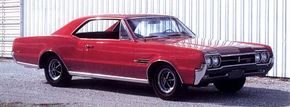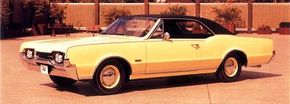Even though the new front-drive Toronado stole much of the spotlight from Oldsmobile's existing models, the sporty 1966-1967 Oldsmobile 4-4-2 was catching hold.
Advertisement
In its mid-1960s restyle, a "Coke-bottle" profile replaced the straight beltline on all F-85 and Cutlass models, including the 4-4-2 series. Performance fans could have their fun in a choice of five models: the F-85 club coupe and Holiday coupe, and a trio of Cutlasses.
As they'd done since 1963, copywriters promoted the 4-4-2 as one of the company's "sports cars," noting that its "cool good looks [were] equally at home at a sports car rally or on a quiet Sunday ride."
Could be, but neither the 4-4-2 nor any brand of American muscle was quite ready to race a pack of Jaguars and Triumphs around a winding course. Straight-off-the-line was where they shined.
Changes were less than drastic under the hood, which carried the 400-cubic-inch V-8 introduced a year earlier, churning out 350 frenzied horses (five more than before). Ordinary F-85/Cutlass models had to make do with a maximum of 330 cubic inches.
In addition to feeling the surge of power, 4-4-2 drivers tuned into the alluring rumble of acoustically tuned twin pipes. Only by checking off a few option boxes, though, would the 4-4-2's recessed instrument selection include a tachometer for consultation, or a console with performance gauges installed. Prices ranged from $2,604 for a 4-4-2 coupe to the $3,118 convertible (about $150 above a plain Cutlass).
This year's "dumbbell"-shaped full-width front panel contained a simple grille opening with single horizontal bar. Quad headlights in square housings filled the ends of the space, with a 4-4-2 insignia in the corner.
Transmission choices beyond the standard column-mounted three-speed included a Hurst four-speed stick, floor-shifted three-speed, and two-speed Jetaway Drive. Strato-Bucket seats and Red-Line tires were part of the 4-4-2's temptations, as was a heavy-duty suspension aimed at reducing rear-end "squat."
With an optional Tri-Carb assembly underhood, a 4-4-2 streaked to 60 mph in 7.2 seconds. The quarter-mile demanded 15.2 seconds. Adding $265 to the car's price and 10 digits to its horsepower rating, the trio of two-barrel carbs "brightens performance several magnitudes," according to Motor Trend. A 4-4-2 handily won Car and Driver magazine's six-car supercar test.
Read about changes for the 1967 model year on the next page.
For more information on cars, see:
- Classic Cars
- Muscle Cars
- Sports Cars
- Consumer Guide New Car Search
- Consumer Guide Used Car Search
Advertisement

